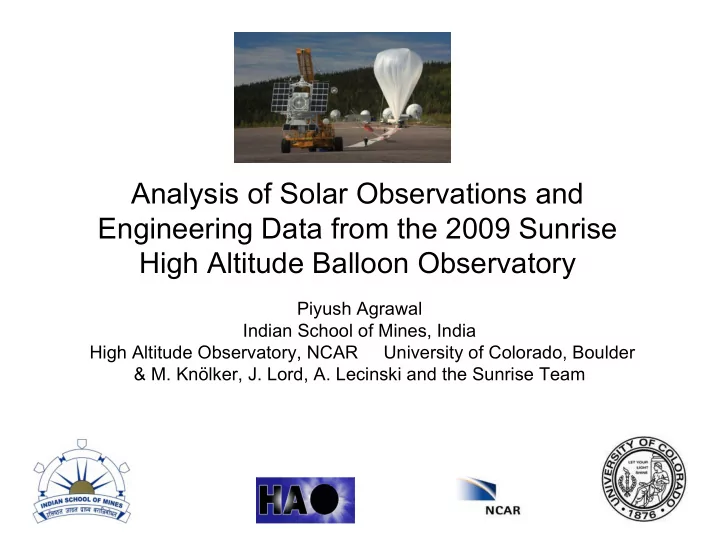

Analysis of Solar Observations and Engineering Data from the 2009 Sunrise High Altitude Balloon Observatory Piyush Agrawal Indian School of Mines, India High Altitude Observatory, NCAR University of Colorado, Boulder & M. Knölker, J. Lord, A. Lecinski and the Sunrise Team
Sunrise Mission : Key Questions • What are the origins and properties of the intermittent magnetic structures? • How is the magnetic flux brought to and removed from the solar surface ? • How does the magnetic field assimilate and provide energy to heat the upper solar atmosphere ? • How does the variable magnetic field modify the solar brightness ? For this : Sunrise provides Intensity maps at resolution of 0.01 arcsecs in UV
Sunrise Balloon-Borne Solar Observatory • Gregory telescope, 1-m aperture • Protective and stabilizing Gondola • 1.3 kW Solar Array + Li-ion batteries • Correlating Wavefront Sensor • Filtergraph : (SuFI) 214nm, 300nm, 313nm, CN, Ca II H • Magnetograph : (IMaX) Provides Dopplergrams and Vector Magnetograms in Fe I 525.02 nm
Sunrise Instruments: Fields of View Telescope FOV = 180 arc sec (approx. 10% of solar diameter)
The REU Project : - The Solar irradiance variations with the solar cycle are very small for visible wavelengths i.e. a fraction of a percent, whereas , they are much larger for the UV and EUV . The project aims to relate this variation to the temporal variations in the number density of small bright magnetic structures
Solar UV transmission profile
Different Pointing Sensors:
The 10 Hz Signal Sunrise Data Sets are imperfect due to vibrations of • various frequencies. We use a periodic 10 Hertz vibration of varying amplitude as a tracer for good data • The inherent noise in the sensor was around 2 to 3 ADU (Analog to Digital Unit) • The level for the 10 Hz range from .1 - 40 ADU • It appears that the sticking azimuthal drive is one source of amplification for the 10 Hz …. but its complicated • Aim : To find the time intervals where the amplitude of the 10 Hz signal was low
Sticking of the flywheel
10Hz Amplitude and Temperature 10 hz amplitude d d d 0 48.6 97.2 136.1 0 48.6 97.2 136.1 Time in minutes Time in minutes
Work Plan I • The Engineering Data contains detailed information on pointing characteristics throughout the flight • Data is in awkward format à develop handling and extraction tools • Look at data following A. Lecinski’s sample analysis • Use Liss Yaw Pointing Data to sort out observing moments of amplitude within [- 200,200] ADU • Look for data therein where pointing is locked
Continued….. • Extraction Tools allow for looking at time series of variable length à choose appropriate time slice • Take the FFT of the subset further obtained to get the amplitude of the 10 Hz vibration • Analyze Observing Data to check whether those moments are indeed of better quality • Proceed with Science Analysis with the Subset of Data • Modify approach if necessary
10 Hz amplitude distribution Good Data Set 10 Hz amplitude 14.00 14.27 14.54 14.81 10 Hz amplitude 17.00 17.14 17.28 17.42 17.54 Bad Data Set Time in hours
Result I : Liss Yaw plot with varying 10Hz amplitude: Liss Yaw with low amplitude of 10Hz signal Liss Yaw with high amplitude
Liss Yaw plot for Sorted Data : Time in hr
Work Plan II Determine Contrast of the Images in the 5 SUFI wavelengths Relate to Solar Irradiance variations in the wavelength range considered
Result II : RMS Intensity Contrast for all wavelengths 214 nm 300 nm 313 nm 388 nm Wavelength 397 nm : Average rms intensity contrast vs Wavelength
RMS 1/3 : 25.87 % RMS 1/2 : 27.27 % RMS Intensity Contrast of different patches RMS 1/3 : 30.26 % of SuFI 214 nm Intensity map : RMS 1/2 : 29.08 % RMS 1/3 : 27.25 % RMS total : 28.19%
RMS INTENSITY CONTRAST 525.02nm 300nm 313nm 388nm MAGNETOGRAM 397nm RMS contrast(%) : 16.21 18.76 17.63 15.64 19.30
Stokes V Profile
Future work • With the tools developed, we will ‘dig deeper’ to find the cause of the 10Hz signal • So far we concentrated on June 9 data, application of the analysis tools to the other data will follow • Then the rms contrast variation with varying magnetic flux content will be studied using all data suitable
Acknowledgments: Michael Knölker Jesse Lord Alice Lecinski Fellow REU students Marty Snow Erin Wood NCAR HAO
Sunrise: Just before the flight
LAUNCH
Data disks O.K. Primary Mirror O.K.
Questions ???
- Thank You
Recommend
More recommend